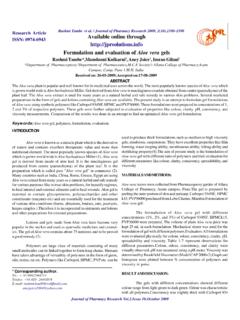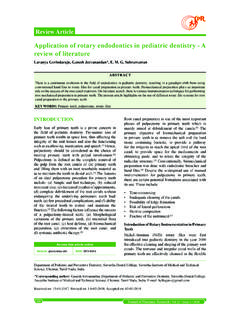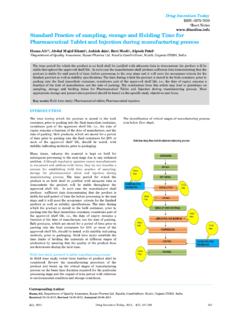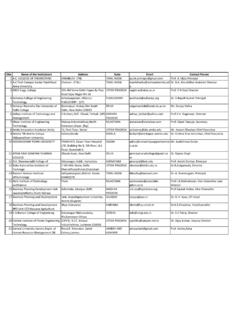Transcription of A Review On: Separation of different process related ...
1 JPR:BioMedRx: An International Journal Issue 2013 Desai Sagar S et al. /JPR:BioMedRx: An International Journal 2013,1(7),673-684673-684 Review ArticleAvailable online *Corresponding Sagar SDepartment of Pharmaceutical Chemistry,Amrutvahini college of Pharmacy,Sangamner, Dist: Ahmednagar,Maharastra, IndiaA Review On: Separation of different process relatedimpurity in tablet formulation of drugDesai Sagar S*, Dr. V. K. Deshmukh, Dr. S. R ChaudhariDepartment of Pharmaceutical Chemistry, Amrutvahini college of Pharmacy, Sangamner, Dist: Ahmednagar,Maharastra, IndiaReceived on:14-03-2013; Revised on:22-04-2013; Accepted on:27-05-2013 ABSTRACTAs new molecular entities are evaluated in clinical development the understanding, identification, quantification and control of impurities indrug substances are essential.
2 As chemical processes used to produce drug substances mature from the early phases of developmentthrough registration, a concomitant maturing of process - related impurity understanding and control is required. Tablet formulations whichare used in different diseases condition containing impurity as per ICH guidelines limit. This paper outlines the Separation of different processrelated impurity in tablet formulation. All authors develop the analytical method for Separation and increase resolution of different processrelated impurity with active pharmaceutical ingredient in tablet word: related substances, residual solvents, metallic catalysts, toxic : 2321-4988 INTRODUCTIONI mpurity profilingImpurity profile of Active Pharmaceutical Ingredient (API) gives anaccount of impurities present in it.
3 Impurity profile is a description ofthe identified and unidentified impurities present in a typical batchof API produced by a specific controlled production process . Regu-latory authorities such as USFDA (United States Food and DrugAdministration), cGMP (Current Good Manufacturing Practice) andMCA (Ministry of corporate Affairs) insist on the impurity profilingof is an ever increasing interest in impurities present in API , not only purity profile but also impurity profile has becomeessential as per regulatory requirements. In the pharmaceutical world,an impurity is considered as any other organic material, besides thedrug substance, or ingredients, arising out of synthesis or unwantedchemicals that remain with API s.
4 The impurity may be developedeither during formulation, or upon aging of both API s and formu-lated API s in medicines [1]. Impurity profile of a substance underinvestigation gives maximum possible types of impurities presentin it. It also estimates the actual amount of different kinds of impuri-ties present in it. The impurity profile is normally dependent upon theprocess or origin of the , qualification and control of impurities in the drugsubstance and drug product, are an important part of drugdevelopment and regulatory assessment. Qualification of theimpurities is the process of acquiring and evaluating data thatestablishes biological safety of an individual impurity or a given im-purity profile at the level specified.
5 Extraction, column chromatogra-phy and preparative separations, etc. are methods generally used forisolation of spectroscopic studies conducted to characterize the structureof actual impurities present in the drug substance above anapparent level of should be described. Hyphenated methodssuch as gas chromatography, mass spectroscopy, or liquidChromatography and the number of other chromatographic methodsare perfectly suitable for the characterization of impurities. During thecourse of drug development studies the qualitative degradation pro-file of a new drug product may change, resulting in new degradationproducts that exceed the identification or qualification threshold.
6 Inthis event, these new degradation products should be identified orqualified [2].In Guidelines impurities in new drug substances are addressedfrom two aspects:1. Chemistry aspects include classification and identification ofimpurities, report generation, setting specification and a brief dis-cussion of analytical Safety aspects include specific guidance for qualifying impuritiesthat were not present in batches of new drug substance used insafetyand clinical :BioMedRx: An International Journal Issue 2013 Desai Sagar S et al. /JPR:BioMedRx: An International Journal 2013,1(7),673-684673-6842.
7 ICH terminology:According to ICH guidelines, impurities in the drug substanceproduced by chemical synthesis can broadly classified impurities, ( process and drug related ) impurities, impurities may arise during the manufacturing process andImpurity [2] is defined as any substance coexisting with the origi-nal drug, such as starting material or intermediates or that is formed,due to any side the pharmaceutical world, an impurity is considered as anyother organic material, besides the drug substance, or ingredients,arising out of synthesis or unwanted chemicals that remain withAPI can also be formed by degradation of the endproduct during manufacturing of the bulk of impurity [3]Impurity can be of three types:1.
8 Impurities closely related to the product and coming from thechemical or from the biosynthetic route itself,2. Impurities formed due to spontaneous decomposition of the drugduring the storage or on exposure to extreme conditions,3. The precursor that may be present in the final product as terms for impurities [3] , penultimate intermediate and by products, products, product, product, of impurities in drug productsVarious types of impurities that may be present in pharmaceuticalsubstance can come from the following materials used, of manufacture adopted, to the instability of product the atmospheric of impurities [4] to United States Pharmacopoeia (USP)
9 In Official volatile impuritiesor storage of the drug substance may be identified or unidentified,volatile or non-volatile, and may materials or intermediates, , products, , , ligands, and impurities can result from the manufacturing process . Theyare normally known and identified and metals or other residual metals, salts, material ( , filter aids, charcoal)ICH limits for impurities [4]According to ICH guidelines on impurities in new drug products,identification of impurities below level is not considered to benecessary, unless potential impurities are expected to be unusuallypotent or toxic.
10 According to ICH, the maximum daily dose qualifica-tion threshold to be considered is as follows; < 2g/day % or 1 mgper day intake (whichever is lower) >2g/day summary, the new drug substance specifications should include,limits Impurities- Each specific identified impurity- Each specific unidentified impurity at or above Any unspecific impurity, with limit of not more than Total impuritiesImpurity typeImpurity drug substanceOrganicStarting materialIntermediateBy-productsImpurity in starting material2. process - related drug productsOrganic or inorganicReagents, catalysts, Degradation drug substance or drug productsOrganicDegradation products4.







